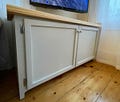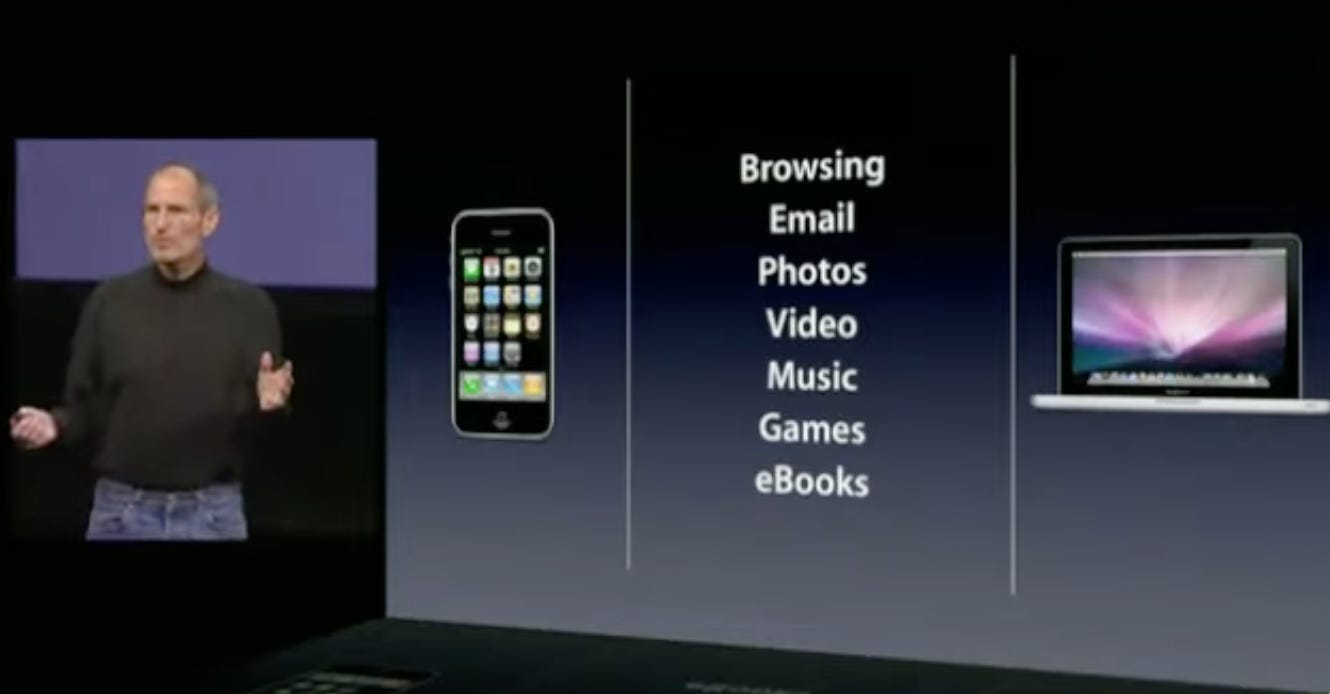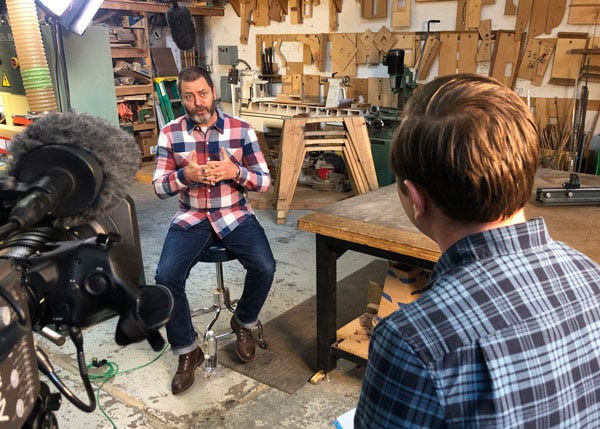Welcome to another edition of Willoughby Hills!
This newsletter explores topics like history, culture, work, urbanism, transportation, travel, agriculture, self-sufficiency, and more.
Back in January of 2010, Steve Jobs unveiled the first iPad to the public.
In his speech introducing the new device, he acknowledged that Apple was already really good at making laptops and really good at making phones (the iPhone had debuted just a few years earlier at this point). According to Jobs in his keynote address:
“And the question has arisen lately, is there room for a third category of device in the middle? Something that’s between a laptop and a smartphone? And of course, we’ve pondered this question for years as well. The bar’s pretty high. In order to really create a new category of devices, those devices are going to have to be far better at doing some key tasks. They’re going to have to be far better at doing some really important things. Better than the laptop, better than the smartphone.
What kind of tasks? Well, things like browsing the web. That’s a pretty tall order. Something that’s better at browsing the web than a laptop? Okay. Doing email. Enjoying and sharing photographs. Video, watching videos. Enjoying your music collection. Playing games. Reading eBooks.”
Jobs and other senior leaders at Apple spent the next 90 or so minutes showcasing the features of the iPad, speaking about the design ethos behind it, and teasing its price and availability.
I remember watching that keynote address with excited anticipation. Steve Jobs was an expert salesperson with a showman’s flair. He could make a pile of rocks sound cutting edge and cause lines to form around the block for them.
I didn’t necessarily need an iPad. After all, as Jobs said in his address, the combination of iPhones for portability and laptops for doing work were still tough to beat. But I definitely wanted one, even if my salary as a production assistant would make acquiring one a bit of a stretch.
I remember having a conversation about the new iPads with an intern who was working with us. The intern also had a part time job at the Apple Store, so I figured he would be an evangelist for the latest Apple product. I was even hoping maybe he’d hook me up with his employee discount.
Instead, I was rather taken aback by his response when I asked if he was planning to get an iPad. The intern was disinterested, stating something like “I see it as only for consuming. I prefer creating.”
It’s an oversimplification perhaps, but it was an incredible insight.
Look back at that list Steve Jobs showed on the screen right before he introduced the iPad: Browsing, Email, Photos, Video, Music, Games, eBooks. They’re all consumption tasks, not creation tasks.
Nearly a decade and a half after iPad’s debut, and that intern’s analysis still holds true. Anyone who truly creates digital content can’t do it with only an iPhone and an iPad, or at least can’t do it as effectively. Nearly all creators still rely on laptops to get the job done. (I’m writing this newsletter on a MacBook Air right now).
I’ve been thinking about how that intern framed consumption versus creation lately and I think there are implications to that idea far beyond the tech world. Those two categories speak to two ways of living and being in this world.
In fairness, we are all consumers and creators at different points in our day and at different points in our life. But on average, are you more of a creator or a consumer?
If we’re not careful, it can be easy to fall into patterns of consumption, especially in our modern world. There are drive thrus scattered all around ready to serve us a quick meal, a cup of coffee, or a car wash. There’s the endless scroll of social media. There’s the consumption of new items to solve problems that we didn’t know we had and didn’t realize needed to be solved.
I grew up immersed in the modern American consumption landscape. I struggled with feelings of worthiness unless I had the newest clothes or the latest gadgets. I strove to upgrade my car every few years, worried what people would think if I drove something out of fashion.
Of course, I had my creative side too. I produced and hosted a public access show in high school, for example. Still on average, I was more of a consumer than a creator.
But at some point, things started to change. I can’t pinpoint the exact moment of the shift, but I remember one inciting incident. My wife’s friend was visiting us. He had grown up in Hawai’i with her and was now living in Vermont working for a carpenter.
As part of showing him around where we lived, we took him to the barn where Ask This Old House is filmed (and where I worked at the time). He was amazed at not only the old tool props decorating the space, but also the nice table saw, band saw, drill press, and workbench in the space.
“You must come up here all the time to just make stuff” I remember him saying. I kind of smiled and waved the question off, but inside I felt a bit of a panic. He was right. I had access to an incredible workshop loaded with tens of thousands of dollars worth of tools (not to mention an expert cast who could mentor and guide me), and I wasn’t making anything out of that!
A few years later, Nick Offerman published his woodworking book Good Clean Fun, which encouraged people to make even simple projects with their hands. Even though Nick and his team at Offerman Wood Shop make some incredible pieces of custom furniture, Nick knew how to break down woodworking to make it accessible. Here’s what he said when we toured his workshop with Ask This Old House on getting people started:
“I just have my students cut off what looks like a nice size cutting board. And a cutting board’s a great place to start because look, you’ve made one cut and you’re almost done. You strike a line, it doesn’t even have to be straight, but you can use it to cut a straight line… you’ll be amazed at how easy, if you take your time and slowly begin to use it, you can make a cut. That alone will feel like a superpower.”
I had a shop, I had somebody breaking it down and making it easier. It was time to create.
I started woodworking and caught the bug. Before long, I would take all of my breaks up in the shop, working on any number of small projects. When my daughter needed a bookcase, I built it. When my son needed a bed, I built it. When we needed a place to store our shoes near the door, I built a bench.
Beyond just woodworking, I became more interested in where my food came from too. I started to dabble in preserving local foods at home. I baked my own bread. I fermented my own sauerkrauts.
As I got busier with making things, I noticed something interesting. I had much less time for consuming. The iPad that I did eventually buy and used mostly for watching movies on long flights starting sitting dormant for longer. I watched less TV.
I also bought less overall. Most of my purchases went to buying good raw ingredients: pastured meat and eggs, local dairy, local organic produce. I stopped eating out as much, and now rarely go to restaurants.
When I was making dinner last night, I knew we had just picked up an abundance of bok choy from our local farm and wanted to used it in a meal. I asked my daughter if she’d rather have fried rice or a homemade ramen soup. She thought about it for a minute, then asked “can we have both?”
I realized that my prep was largely the same for both dishes- the main difference would be whether the dish ended with rice added or noodles and broth. “Sure” I told her, “let’s have both.”
In the time that it used to take me to heat up a frozen pizza or make a simple dish like noodles and sauce, I created two homemade dinners loaded with fresh, local vegetables.
And there was nothing better than when my daughter took her first bite of soup and said “wow, this is really good!” And then she followed it up by making it her own- adding freshly ground pepper and some fermented carrots. Creating.
At the end of the day, I think humans were meant to create more than consume. Our modern convenience culture may tell us otherwise, but I never feel more in touch with our world and my own humanity than when I’m creating something.
Thanks for reading Willoughby Hills! Subscribe for free to receive new posts and support my work.
Related Reading
If you’ve missed past issues of this newsletter, they are available to read here.







yep, creating is more engaging and cognitively complex than consuming. However, what's created usually needs an audience to consume it, often as a measure of its success or purpose. The imbalance of time utilization on creating vs. consuming, especially digital content, is our latest productivity challenge.